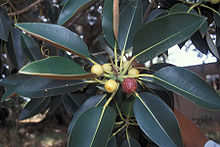Large-leaved fig
| Large-leaved fig | ||||||||||||
|---|---|---|---|---|---|---|---|---|---|---|---|---|

Ficus macrophylla in the Palermo Botanical Garden |
||||||||||||
| Systematics | ||||||||||||
|
||||||||||||
| Scientific name | ||||||||||||
| Ficus macrophylla | ||||||||||||
| Desf. ex pers. |
The large-leaved fig ( Ficus macrophylla ) is a species of the subgenus Urostigma from the genus of figs (Ficus) in the mulberry family (Moraceae). The large-leaved fig is native to northeast Australia.
The pollinator of the large-leaved fig is the fig wasp Pleistodontes froggatti .
description
Appearance and leaf
The large-leaved fig grows as a large, evergreen tree and reaches heights of up to 55 meters with a trunk diameter of up to 2 meters. The trunk forms numerous buttress roots . The crown is wide. Starting from the branches, numerous aerial roots form, which, if they are of sufficient length, can take root in the ground. The subspecies Ficus macrophylla subsp. Columnaris differs in that it begins its growth as an epiphyte , then reaches the ground with the roots and never forms a continuous trunk.
The alternate leaves are stalked 5 to 10 cm long. With a length of 10 to 25 cm and a width of 7 to 10 cm, the leaf blade is elliptical to elongated and ends pointed or with a blunt tip attached, at the base it is wedge-shaped or slightly rounded. The underside of the leaf is hairy reddish, the hair disappears over time. On each side of the main vein, 13 to 16 leaf veins branch off . The conspicuous stipules are 5 to 10 cm in length, up to 15 cm, pointed, also slightly hairy or glabrous.
Inflorescence and flower
The inflorescence is how the genuine fig ( Ficus carica known), a Syconium . The inflorescences stand together in pairs, they are round or somewhat oblong with a length of 1.8 to 2.5 cm and a diameter of 1.5 to 2.4 cm. The peduncle measures 2 to 2.5 cm with a diameter of 0.6 cm, on it sit two broad, oval bracts . The opening of the fig is very small and barely raised above the surface of the fruit, around the opening are three small lobes.
The male flowers are stalked and have three or four bracts. The female leaves have a short stem and usually three bloom, the short stylus bears an undivided scar .
The inflorescences are still green, the fruits later turn dark red with yellowish-green spots.
distribution
The large-leaved fig comes from the east coast of Australia . It occurs from northeast Queensland to New South Wales . It grows there in the rainforests of the lowlands as well as in mountain rainforests. The columnaris subspecies is endemic to Lord Howe Island . It takes its English name "Moreton Bay Fig" from Moreton Bay in Queensland.
Systematics and botanical history
The first description was by René Desfontaines and appeared in 1807 in the second volume by Christian Hendrik Persoons : Synopsis Plantarum , page 609. A homonym is Ficus macrophylla Roxb. & Buch.-Ham. ex Sm. (published in The cyclopædia; or, Universal dictionary of arts, sciences, and literature , 14, 1810, p. 32). Synonyms for Ficus macrophylla Desf. ex pers. include Ficus macrocarpa Blume and Ficus magnolioides Borzi .
Within the large genus Ficus , the large-leaved fig is classified in the sub-genus Urostigma , there in the Malvanthera section and further in the Malvanthereae sub- section . The closest related species is Ficus pleurocarpa .
use
The large-leaved fig is cultivated as an ornamental wood. It is used in California, Florida, Hawaii and New Zealand. In the 19th century, the large-leaved fig was also imported to Europe. The botanist Antonino Borzì , director of the Botanical Garden Palermo , described the species in 1897 and named it Ficus magnolioides because its leaf shape is similar to that of a magnolia . Specimens of this species had already been introduced to Palermo in 1840 and planted in the Palermo Botanical Gardens, the Giardino Inglese , the Giardino Garibaldi and the Villa Whitaker .
Individual evidence
- ↑ a b c d e Forest Starr, Kim Starr, Lloyd Loope: Ficus macrophylla - Moreton bay fig - Moraceae. United States Geological Survey - Biological Resources Division Haleakala Field Station, Maui, Hawai'i, 2003. ( Online ; PDF; 20 kB)
- ↑ a b c d e f Flora of Australia: Ficus macrophylla Desf. ex pers. subsp. macrophylla Moreton Bay Fig. ( Online )
- ↑ a b c d Dale J. Dixon: A taxonomic revision of the Australian Ficus species in the section Malvanthera (Ficus subg.Urostigma: Moraceae) . In: Telopea . tape 10 , no. 1 , 2003, p. 125-153 .
- ↑ a b G. J. Harden: Ficus macrophylla - online in the Flora of New South Wales Online .
- ↑ a b Abdul Ghafoor: Ficus macrophylla - online in the Flora of Pakistan .
- ↑ Ficus macrophylla at Tropicos.org. Missouri Botanical Garden, St. Louis
- ↑ Nina Rønsted, George D. Weiblen, V. Savolainen, James M. Cook: Phylogeny, biogeography, and ecology of Ficus section Malvanthera (Moraceae) . In: Molecular Phylogenetics and Evolution . tape 48 , 2008, p. 12-22 .
